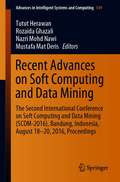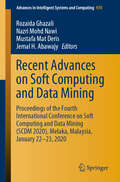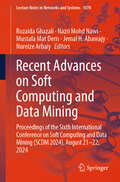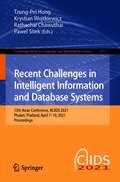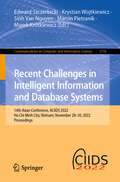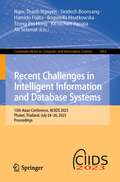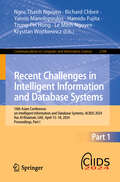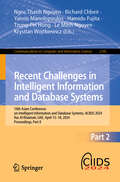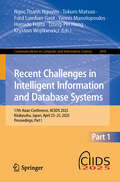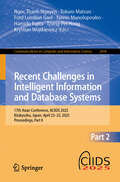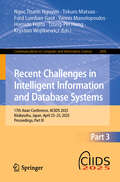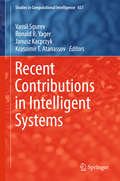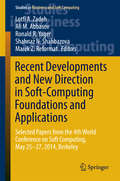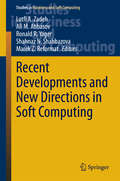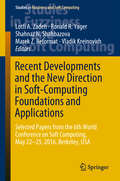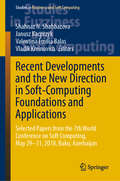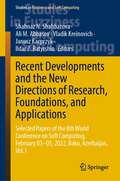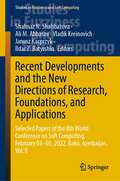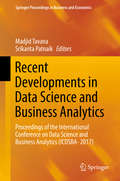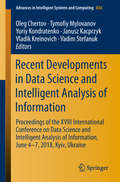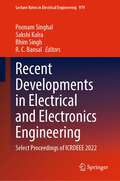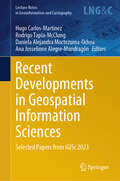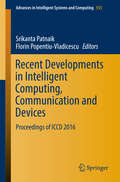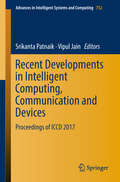- Table View
- List View
Recent Advances on Soft Computing and Data Mining
by Tutut Herawan Rozaida Ghazali Nazri Mohd Nawi Mustafa Mat DerisThis book provides a comprehensive introduction and practical look at the concepts and techniques readers need to get the most out of their data in real-world, large-scale data mining projects. It also guides readers through the data-analytic thinking necessary for extracting useful knowledge and business value from the data. The book is based on the Soft Computing and Data Mining (SCDM-16) conference, which was held in Bandung, Indonesia on August 18th-20th 2016 to discuss the state of the art in soft computing techniques, and offer participants sufficient knowledge to tackle a wide range of complex systems. The scope of the conference is reflected in the book, which presents a balance of soft computing techniques and data mining approaches. The two constituents are introduced to the reader systematically and brought together using different combinations of applications and practices. It offers engineers, data analysts, practitioners, scientists and managers the insights into the concepts, tools and techniques employed, and as such enables them to better understand the design choice and options of soft computing techniques and data mining approaches that are necessary to thrive in this data-driven ecosystem.
Recent Advances on Soft Computing and Data Mining: Proceedings of the Fourth International Conference on Soft Computing and Data Mining (SCDM 2020), Melaka, Malaysia, January 22–23, 2020 (Advances in Intelligent Systems and Computing #978)
by Jemal H. Abawajy Rozaida Ghazali Nazri Mohd Nawi Mustafa Mat DerisThis book provides an introduction to data science and offers a practical overview of the concepts and techniques that readers need to get the most out of their large-scale data mining projects and research studies. It discusses data-analytical thinking, which is essential to extract useful knowledge and obtain commercial value from the data. Also known as data-driven science, soft computing and data mining disciplines cover a broad interdisciplinary range of scientific methods and processes. The book provides readers with sufficient knowledge to tackle a wide range of issues in complex systems, bringing together the scopes that integrate soft computing and data mining in various combinations of applications and practices, since to thrive in these data-driven ecosystems, researchers, data analysts and practitioners must understand the design choice and options of these approaches. This book helps readers to solve complex benchmark problems and to better appreciate the concepts, tools and techniques used.
Recent Advances on Soft Computing and Data Mining: Proceedings of the Sixth International Conference on Soft Computing and Data Mining (SCDM 2024), August 21-22, 2024 (Lecture Notes in Networks and Systems #1078)
by Jemal H. Abawajy Rozaida Ghazali Nazri Mohd Nawi Mustafa Mat Deris Nureize ArbaiyThis book explores methods for leveraging data to create innovative solutions that offer significant and meaningful value. It provides practical insights into the concepts and techniques essential for maximizing the outcomes of large-scale research and data mining projects. Readers are guided through analytical thinking processes, addressing challenges in deciphering complex data systems and deriving commercial value from the data. Soft computing and data mining, also known as data-driven science, encompass a diverse range of interdisciplinary scientific methods and processes. The proceedings of "Recent Advances on Soft Computing and Data Mining" provide comprehensive knowledge to address various challenges encountered in complex systems. By integrating practices and applications from both domains, it offers a robust framework for tackling these issues. To excel in data-driven ecosystems, researchers, data analysts, and practitioners must carefully select the most suitable approaches and tools. Understanding the design choices and options available is essential for appreciating the underlying concepts, tools, and techniques utilized in these endeavors.
Recent Advances on Soft Computing and Data Mining: The Second International Conference on Soft Computing and Data Mining (SCDM-2016), Bandung, Indonesia, August 18-20, 2016 Proceedings (Advances in Intelligent Systems and Computing #549)
by Tutut Herawan Rozaida Ghazali Nazri Mohd Nawi Mustafa Mat DerisThis book provides a comprehensive introduction and practical look at the concepts and techniques readers need to get the most out of their data in real-world, large-scale data mining projects. It also guides readers through the data-analytic thinking necessary for extracting useful knowledge and business value from the data.The book is based on the Soft Computing and Data Mining (SCDM-16) conference, which was held in Bandung, Indonesia on August 18th–20th 2016 to discuss the state of the art in soft computing techniques, and offer participants sufficient knowledge to tackle a wide range of complex systems. The scope of the conference is reflected in the book, which presents a balance of soft computing techniques and data mining approaches. The two constituents are introduced to the reader systematically and brought together using different combinations of applications and practices. It offers engineers, data analysts, practitioners, scientists and managers the insights into the concepts, tools and techniques employed, and as such enables them to better understand the design choice and options of soft computing techniques and data mining approaches that are necessary to thrive in this data-driven ecosystem.
Recent Challenges in Intelligent Information and Database Systems: 13th Asian Conference, ACIIDS 2021, Phuket, Thailand, April 7–10, 2021, Proceedings (Communications in Computer and Information Science #1371)
by Tzung-Pei Hong Krystian Wojtkiewicz Rathachai Chawuthai Pawel SitekThis volume constitutes the refereed proceedings of the 13th Asian Conference on Intelligent Information and Database Systems, ACIIDS 2021, held in Phuket, Thailand, in April 2021. The total of 35 full papers accepted for publication in these proceedings were carefully reviewed and selected from 291 submissions. The papers are organized in the following topical sections: data mining and machine learning methods; advanced data mining techniques and applications; intelligent and contextual systems; natural language processing; network systems and applications; computational imaging and vision; decision support and control systems; data modelling and processing for Industry 4.0.
Recent Challenges in Intelligent Information and Database Systems: 14th Asian Conference, ACIIDS 2022, Ho Chi Minh City, Vietnam, November 28-30, 2022, Proceedings (Communications in Computer and Information Science #1716)
by Edward Szczerbicki Marcin Pietranik Marek Krótkiewicz Krystian Wojtkiewicz Sinh Van NguyenThis book constitutes the refereed proceedings of the 14th Asian Conference on Intelligent Information and Database Systems, ACIIDS 2022, held in Ho Chi Minh City, Vietnam, in November 2022. This volume contains 60 peer-reviewed papers selected for poster presentation from 406 submissions. Papers included in this volume cover the following topics: data mining and machine learning methods, advanced data mining techniques and applications, intelligent and contextual systems, natural language processing, network systems and applications, computational imaging and vision, decision support and control systems, and data modeling and processing for industry 4.0.
Recent Challenges in Intelligent Information and Database Systems: 15th Asian Conference, ACIIDS 2023, Phuket, Thailand, July 24–26, 2023, Proceedings (Communications in Computer and Information Science #1863)
by Tzung-Pei Hong Ngoc Thanh Nguyen Hamido Fujita Ali Selamat Bogumiła Hnatkowska Kitsuchart Pasupa Siridech BoonsangThis book constitutes the second part of the proceedings of the 15th Asian Conference on Intelligent Information and Database Systems, ACIIDS 2023, held in Phuket, Thailand, during July 24–26, 2023.The 50 full papers included in this book were carefully reviewed and selected from 224 submissions. They were organized in topical sections as follows: Computer Vision, Cybersecurity and Fraud Detection, Data Analysis, Modeling, and Processing, Data Mining and Machine Learning, Forecasting and Optimization Techniques, Healthcare and Medical Applications, Speech and Text Processing.
Recent Challenges in Intelligent Information and Database Systems: 16th Asian Conference on Intelligent Information and Database Systems, ACIIDS 2024, Ras Al Khaimah, UAE, April 15–18, 2024, Proceedings, Part I (Communications in Computer and Information Science #2144)
by Richard Chbeir Tzung-Pei Hong Ngoc Thanh Nguyen Yannis Manolopoulos Hamido Fujita Le Minh Nguyen Krystian WojtkiewiczThis book constitutes the proceedings of the 16th Asian Conference on Intelligent Information and Database Systems, ACIIDS 2024, held in Ras Al Khaimah, UAE, during April 15–18, 2024. The 58 full papers are presented in this book were carefully reviewed and selected from 251 submissions. They are organized in topical sections as follows: Part One: AI-driven Cybersecurity Solutions; AI-driven Medical Analytics; Computational Intelligence; and Data Modelling and Information Systems. Part Two: Image and Video Processing; Prediction and Recommendation Systems; and Text, Speech and Natural Language Processing.
Recent Challenges in Intelligent Information and Database Systems: 16th Asian Conference on Intelligent Information and Database Systems, ACIIDS 2024, Ras Al Khaimah, UAE, April 15–18, 2024, Proceedings, Part II (Communications in Computer and Information Science #2145)
by Richard Chbeir Tzung-Pei Hong Ngoc Thanh Nguyen Yannis Manolopoulos Hamido Fujita Le Minh Nguyen Krystian WojtkiewiczThis book constitutes the proceedings of the 16th Asian Conference on Intelligent Information and Database Systems, ACIIDS 2024, held in Ras Al Khaimah, UAE, during April 15–18, 2024. The 58 full papers are presented in this book were carefully reviewed and selected from 251 submissions. They are organized in topical sections as follows: Part One: AI-driven Cybersecurity Solutions; AI-driven Medical Analytics; Computational Intelligence; and Data Modelling and Information Systems. Part Two: Image and Video Processing; Prediction and Recommendation Systems; and Text, Speech and Natural Language Processing.
Recent Challenges in Intelligent Information and Database Systems: 17th Asian Conference, ACIIDS 2025, Kitakyushu, Japan, April 23-25, 2025, Proceedings, Part I (Communications in Computer and Information Science #2493)
by Tzung-Pei Hong Ngoc Thanh Nguyen Yannis Manolopoulos Tokuro Matsuo Ford Lumban Gaol Hamido Fujita Krystian WojtkiewiczThis three-volume set CCIS 2493–2495 constitutes the refereed proceedings of the 17th Asian Conference on Recent Challenges in Intelligent Information and Database Systems, ACIIDS 2025, held in Kitakyushu, Japan, during April 23-25, 2025. The 80 papers included in these proceedings were carefully reviewed and selected from 301 submissions. The papers are organized in the following topical sections: Volume I: Data Analysis and Signal Processing; Development and Application of Large Language Models; Speech and Natural Language Processing. Volume II: Artificial Intelligence in Multimedia Technologies; Image and Video Processing. Volume III: Machine Learning and Artificial Intelligence Applications; Intelligent Information Systems and Advanced Problem-Solving Algorithms.
Recent Challenges in Intelligent Information and Database Systems: 17th Asian Conference, ACIIDS 2025, Kitakyushu, Japan, April 23-25, 2025, Proceedings, Part II (Communications in Computer and Information Science #2494)
by Tzung-Pei Hong Ngoc Thanh Nguyen Yannis Manolopoulos Tokuro Matsuo Ford Lumban Gaol Hamido Fujita Krystian WojtkiewiczThis three-volume set CCIS 2493–2495 constitutes the refereed proceedings of the 17th Asian Conference on Recent Challenges in Intelligent Information and Database Systems, ACIIDS 2025, held in Kitakyushu, Japan, during April 23-25, 2025. The 80 papers included in these proceedings were carefully reviewed and selected from 301 submissions. The papers are organized in the following topical sections: Volume I: Data Analysis and Signal Processing; Development and Application of Large Language Models; Speech and Natural Language Processing. Volume II: Artificial Intelligence in Multimedia Technologies; Image and Video Processing. Volume III: Machine Learning and Artificial Intelligence Applications; Intelligent Information Systems and Advanced Problem-Solving Algorithms.
Recent Challenges in Intelligent Information and Database Systems: 17th Asian Conference, ACIIDS 2025, Kitakyushu, Japan, April 23-25, 2025, Proceedings, Part III (Communications in Computer and Information Science #2495)
by Tzung-Pei Hong Ngoc Thanh Nguyen Yannis Manolopoulos Tokuro Matsuo Ford Lumban Gaol Hamido Fujita Krystian WojtkiewiczThis three-volume set CCIS 2493–2495 constitutes the refereed proceedings of the 17th Asian Conference on Recent Challenges in Intelligent Information and Database Systems, ACIIDS 2025, held in Kitakyushu, Japan, during April 23-25, 2025. The 80 papers included in these proceedings were carefully reviewed and selected from 301 submissions. The papers are organized in the following topical sections: Volume I: Data Analysis and Signal Processing; Development and Application of Large Language Models; Speech and Natural Language Processing. Volume II: Artificial Intelligence in Multimedia Technologies; Image and Video Processing. Volume III: Machine Learning and Artificial Intelligence Applications; Intelligent Information Systems and Advanced Problem-Solving Algorithms.
Recent Contributions in Intelligent Systems
by Krassimir T. Atanassov Ronald R. Yager Janusz Kacprzyk Vassil SgurevThis volume is a brief, yet comprehensive account of new development, tools, techniques and solutions in the broadly perceived "intelligent systems". New concepts and ideas concern the development of effective and efficient models which would make it possible to effectively and efficiently describe and solve processes in various areas of science and technology. Special emphasis is on the dealing with uncertainty and imprecision that permeates virtually all real world processes and phenomena, and has to properly be modeled by formal and algorithmic tools and techniques so that they be adequate and useful. The papers in this volume concern a wide array of possible techniques exemplified by, on the one hand, logic, probabilistic, fuzzy, intuitionistic fuzzy, neuro-fuzzy, etc. approaches. On the other hand, they represent the use of such systems modeling tools as generalized nets, optimization and control models, systems analytic models, etc. They concerns a variety of approaches, from pattern recognition, image analysis, education system modeling, biological and medical systems modeling, etc.
Recent Developments and New Direction in Soft-Computing Foundations and Applications
by Lotfi A. Zadeh Ronald R. Yager Marek Z. Reformat Ali M. Abbasov Shahnaz N. ShahbazovaThis book reports on advancedtheories and cutting-edge applications in the field of soft computing. Theindividual chapters, written by leading researchers, are based on contributionspresented during the 4th World Conference on Soft Computing, held May 25-27,2014, in Berkeley. The book covers a wealth of key topics in soft computing,focusing on both fundamental aspects and applications. The former include fuzzymathematics, type-2 fuzzy sets, evolutionary-based optimization, aggregationand neural networks, while the latter include soft computing in data analysis,image processing, decision-making, classification, series prediction,economics, control, and modeling. By providing readers with a timely,authoritative view on the field, and by discussing thought-provokingdevelopments and challenges, the book will foster new research directions inthe diverse areas of soft computing.
Recent Developments and New Directions in Soft Computing
by Lotfi A. Zadeh Ronald R. Yager Marek Z. Reformat Ali M. Abbasov Shahnaz N. ShahbazovaThe book reports on the latest advances and challenges of soft computing. It gathers original scientific contributions written by top scientists in the field and covering theories, methods and applications in a number of research areas related to soft-computing, such as decision-making, probabilistic reasoning, image processing, control, neural networks and data analysis.
Recent Developments and the New Direction in Soft-Computing Foundations and Applications: Selected Papers From The 6th World Conference On Soft Computing, May 22-25, 2016, Berkeley, Usa (Studies in Fuzziness and Soft Computing #361)
by Lotfi A. Zadeh Ronald R. Yager Marek Z. Reformat Vladik Kreinovich Shahnaz N. ShahbazovaThis book is an authoritative collection of contributions in the field of soft-computing. Based on selected works presented at the 6th World Conference on Soft Computing, held on May 22-25, 2016, in Berkeley, USA, it describes new theoretical advances, as well as cutting-edge methods and applications. Theories cover a wealth of topics, such as fuzzy logic, cognitive modeling, Bayesian and probabilistic methods, multi-criteria decision making, utility theory, approximate reasoning, human-centric computing and many others. Applications concerns a number of fields, such as internet and semantic web, social networks and trust, control and robotics, computer vision, medicine and bioinformatics, as well as finance, security and e-Commerce, among others. Dedicated to the 50th Anniversary of Fuzzy Logic and to the 95th Birthday Anniversary of Lotfi A. Zadeh, the book not only offers a timely view on the field, yet it also discusses thought-provoking developments and challenges, thus fostering new research directions in the diverse areas of soft computing.
Recent Developments and the New Direction in Soft-Computing Foundations and Applications: Selected Papers from the 7th World Conference on Soft Computing, May 29–31, 2018, Baku, Azerbaijan (Studies in Fuzziness and Soft Computing #393)
by Janusz Kacprzyk Valentina Emilia Balas Vladik Kreinovich Shahnaz N. ShahbazovaThis book gathers authoritative contributions in the field of Soft Computing. Based on selected papers presented at the 7th World Conference on Soft Computing, which was held on May 29–31, 2018, in Baku, Azerbaijan, it describes new theoretical advances, as well as cutting-edge methods and applications. New theories and algorithms in fuzzy logic, cognitive modeling, graph theory and metaheuristics are discussed, and applications in data mining, social networks, control and robotics, geoscience, biomedicine and industrial management are described. This book offers a timely, broad snapshot of recent developments, including thought-provoking trends and challenges that are yielding new research directions in the diverse areas of Soft Computing.
Recent Developments and the New Directions of Research, Foundations, and Applications: Selected Papers of the 8th World Conference on Soft Computing, February 03–05, 2022, Baku, Azerbaijan, Vol. I (Studies in Fuzziness and Soft Computing #422)
by Janusz Kacprzyk Vladik Kreinovich Ali M. Abbasov Shahnaz N. Shahbazova Ildar Z. BatyrshinThis book is a collection of papers presented during the 8th World Conference on Soft Computing in February 2022. The papers cover multiple areas important for soft computing. Some papers are dedicated to fundamental aspects of soft computing, i.e., fuzzy mathematics, type-2 fuzzy sets, evolutionary-based optimization, aggregation, and neural networks. Others emphasize the application of soft computing methods to data analysis, image processing, decision-making, classification, series prediction, economics, control, and modeling.
Recent Developments and the New Directions of Research, Foundations, and Applications: Selected Papers of the 8th World Conference on Soft Computing, February 03–05, 2022, Baku, Azerbaijan, Vol. II (Studies in Fuzziness and Soft Computing #423)
by Janusz Kacprzyk Vladik Kreinovich Ali M. Abbasov Shahnaz N. Shahbazova Ildar Z. BatyrshinThis book is a collection of papers presented during the 8th World Conference on Soft Computing in February 2022. The papers cover multiple areas important for soft computing. Some papers are dedicated to fundamental aspects of soft computing, i.e., fuzzy mathematics, type-2 fuzzy sets, evolutionary-based optimization, aggregation, and neural networks. Others emphasize the application of soft computing methods to data analysis, image processing, decision-making, classification, series prediction, economics, control, and modeling.
Recent Developments in Data Science and Business Analytics: Proceedings Of The International Conference On Data Science And Business Analytics (icdsba- 2017) (Springer Proceedings In Business And Economics)
by Madjid Tavana Srikanta PatnaikThis edited volume is brought out from the contributions of the research papers presented in the International Conference on Data Science and Business Analytics (ICDSBA- 2017), which was held during September 23-25 2017 in ChangSha, China. As we all know, the field of data science and business analytics is emerging at the intersection of the fields of mathematics, statistics, operations research, information systems, computer science and engineering. Data science and business analytics is an interdisciplinary field about processes and systems to extract knowledge or insights from data. Data science and business analytics employ techniques and theories drawn from many fields including signal processing, probability models, machine learning, statistical learning, data mining, database, data engineering, pattern recognition, visualization, descriptive analytics, predictive analytics, prescriptive analytics, uncertainty modeling, big data, data warehousing, data compression, computer programming, business intelligence, computational intelligence, and high performance computing among others. The volume contains 55 contributions from diverse areas of Data Science and Business Analytics, which has been categorized into five sections, namely: i) Marketing and Supply Chain Analytics; ii) Logistics and Operations Analytics; iii) Financial Analytics. iv) Predictive Modeling and Data Analytics; v) Communications and Information Systems Analytics. The readers shall not only receive the theoretical knowledge about this upcoming area but also cutting edge applications of this domains.
Recent Developments in Data Science and Intelligent Analysis of Information: Proceedings of the XVIII International Conference on Data Science and Intelligent Analysis of Information, June 4–7, 2018, Kyiv, Ukraine (Advances in Intelligent Systems and Computing #836)
by Janusz Kacprzyk Vladik Kreinovich Yuriy Kondratenko Oleg Chertov Tymofiy Mylovanov Vadim StefanukThis book constitutes the proceedings of the XVIII International Conference on Data Science and Intelligent Analysis of Information (ICDSIAI'2018), held in Kiev, Ukraine on June 4-7, 2018. The conference series, which dates back to 2001 when it was known as the Workshop on Intelligent Analysis of Information, was renamed in 2008 to reflect the broadening of its scope and the composition of its organizers and participants. ICDSIAI'2018 brought together a large number of participants from numerous countries in Europe, Asia and the USA. The papers presented addressed novel theoretical developments in methods, algorithms and implementations for the broadly perceived areas of big data mining and intelligent analysis of data and information, representation and processing of uncertainty and fuzziness, including contributions on a range of applications in the fields of decision-making and decision support, economics, education, ecology, law, and various areas of technology. The book is dedicated to the memory of the conference founder, the late Professor Tetiana Taran, an outstanding scientist in the field of artificial intelligence whose research record, vision and personality have greatly contributed to the development of Ukrainian artificial intelligence and computer science.
Recent Developments in Electrical and Electronics Engineering: Select Proceedings of ICRDEEE 2022 (Lecture Notes in Electrical Engineering #979)
by Bhim Singh Poonam Singhal Sakshi Kalra R. C. BansalThis book contains cutting-edge research content presented by researchers, engineers, developers, and practitioners from academia and industry at the International Conference on Recent Developments in Electrical and Electronics Engineering (ICRDEEE 2022). The materials in the book include theory and applications for different areas of Electrical and Electronics Engineering. The topics covered include power systems and protection, energy, electric vehicles, smart grid, semiconductor technologies, electrical machines and drives, control systems with artificial intelligence, etc. The content is useful for researchers, professionals, and academicians in understanding current research trends, findings, and future scope of research in electrical and electronics engineering models.
Recent Developments in Geospatial Information Sciences: Selected Papers from iGISc 2023 (Lecture Notes in Geoinformation and Cartography)
by Rodrigo Tapia-McClung Hugo Carlos-Martinez Daniela Alejandra Moctezuma-Ochoa Ana Josselinne Alegre-MondragónThis book presents a selection of manuscripts submitted to the 3rd International Conference on Geospatial Information Sciences (iGISc) 2023, a hybrid conference held in November 2023. These papers were selected by the Scientific Program Committee of the Conference after a rigorous peer-reviewed process. They represent a sample of the wide range of applications that characterize the interdisciplinary research areas of the Geospatial Information Sciences. It especially represents a fabulous opportunity to exhibit research carried out by young researchers and showcase it to the rest of the world and enhance the growth of the sciences while, at the same time, enforces them to level up with other research at the international level.
Recent Developments in Intelligent Computing, Communication and Devices
by Srikanta Patnaik Florin Popentiu-VladicescuThe book presents high quality papers presented at 2nd International Conference on Intelligent Computing, Communication & Devices (ICCD 2016) organized by Interscience Institute of Management and Technology (IIMT), Bhubaneswar, Odisha, India, during 13 and 14 August, 2016. The book covers all dimensions of intelligent sciences in its three tracks, namely, intelligent computing, intelligent communication and intelligent devices. intelligent computing track covers areas such as intelligent and distributed computing, intelligent grid and cloud computing, internet of things, soft computing and engineering applications, data mining and knowledge discovery, semantic and web technology, hybrid systems, agent computing, bioinformatics, and recommendation systems. Intelligent communication covers communication and network technologies, including mobile broadband and all optical networks that are the key to groundbreaking inventions of intelligent communication technologies. This covers communication hardware, software and networked intelligence, mobile technologies, machine-to-machine communication networks, speech and natural language processing, routing techniques and network analytics, wireless ad hoc and sensor networks, communications and information security, signal, image and video processing, network management, and traffic engineering. And finally, the third track intelligent device deals with any equipment, instrument, or machine that has its own computing capability. As computing technology becomes more advanced and less expensive, it can be built into an increasing number of devices of all kinds. The intelligent device covers areas such as embedded systems, RFID, RF MEMS, VLSI design and electronic devices, analog and mixed-signal IC design and testing, MEMS and microsystems, solar cells and photonics, nanodevices, single electron and spintronics devices, space electronics, and intelligent robotics.
Recent Developments in Intelligent Computing, Communication and Devices: Proceedings Of Iccd 2016 (Advances In Intelligent Systems and Computing #555)
by Vipul Jain Srikanta PatnaikThis book offers a collection of high-quality, peer-reviewed research papers presented at the International Conference on Intelligent Computing, Communication and Devices (ICCD 2017), discussing all dimensions of intelligent sciences – intelligent computing, intelligent communication, and intelligent devices. Intelligent computing addresses areas such as intelligent and distributed computing, intelligent grid and cloud computing, internet of things, soft computing and engineering applications, data mining and knowledge discovery, semantic and web technology, hybrid systems, agent computing, bioinformatics, and recommendation systems. Intelligent communication is concerned with communication and network technologies, such as mobile broadband and all optical networks that are the key to groundbreaking inventions of intelligent communication technologies. It includes communication hardware, software and networked intelligence, mobile technologies, machine-to-machine communication networks, speech and natural language processing, routing techniques and network analytics, wireless ad hoc and sensor networks, communications and information security, signal, image and video processing, network management, and traffic engineering. Lastly, intelligent devices are any equipment, instruments, or machines that have their own computing capability. As computing technology becomes more advanced and less expensive, it can be incorporated an increasing number of devices of all kinds. This area covers such as embedded systems, radiofrequency identification (RFID), radiofrequency microelectromechanical system (RF MEMS), very-large-scale integration (VLSI) design and electronic devices, analog and mixed-signal integrated circuit (IC) design and testing, microelectromechanical system (MEMS) and microsystems, solar cells and photonics, nanodevices, single electron and spintronics devices, space electronics, and intelligent robotics.
